These bright fungi are rather unusual looking, and if you’re trying them for the first time, you may be a little skeptical about their edibility.
But they’re extremely popular with foragers, very versatile in the kitchen and many people consider them the best mushroom to substitute for chicken.
So, if you’re looking for a healthy vegetarian alternative to chicken and live in an area where they thrive, these may be the perfect mushrooms for you.
Read on to learn more about chicken of the woods mushrooms, including where they grow, how to correctly identify them, what they taste like and how to harvest, store, clean and cook them.
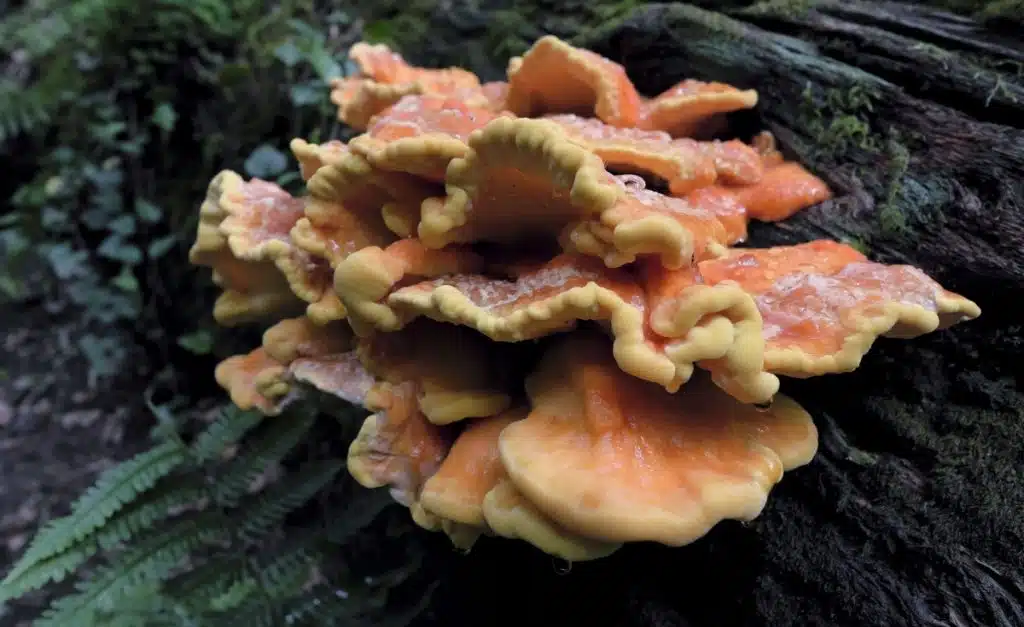
What Are Chicken of The Woods Mushrooms?
Chicken of the woods mushrooms are striking, brightly-colored edible mushrooms that grow on old, dying or dead trees.
They’re the fruiting bodies of polypore, bracket fungi and appear in large tiered clusters of bright yellow to orange mushrooms with fan-shaped caps.
They’re occasionally parasitic on elderly trees where they cause brown rot, but usually saprotrophic, feeding on dead and decaying hardwood trees.
There are several species of chicken of the woods mushrooms that vary slightly in color and taste. Three of the most common are Laetiporus sulphureus, Laetiporus cincinnatus and Laetiporus gilbertsonii.
All three produce delicious edible mushrooms that look similar but grow on different trees.
Like other mushrooms, chicken of the woods has several names, including sulfur shelf or chicken mushrooms, sulfur shelf fungus or chicken fungus.
Can You Eat Chicken of the Woods Mushroom?
Yes, you can eat chicken of the woods, and it gets its name from the fact that its dense fibrous flesh has a texture very similar to cooked chicken.
Where Does Chicken of the Woods Grow?
Chicken of the woods grow in deciduous woodlands, and you’ll find them in a range of woodland habitats, including the edges of natural forests and urban parks and gardens.
They’re widespread in the United Kingdom, North America, and Europe and are most often found growing on trunks or stumps of deciduous hardwood trees like oaks, maples and beeches.
But you’ll sometimes find them growing on willow, wild cherry, sweet chestnut, eucalyptus and yew.
Laetiporus sulphureus and Laetiporus cincinnatus enjoy oak and beech trees, while Laetiporus gilbertsonii is usually found on oak or eucalyptus trees.
Some mycologists advise against harvesting chicken of the woods mushrooms that grow on yew trees as they could absorb the toxic alkaloids found in the yew tree. But others report having eaten these mushrooms without incident.

Is Chicken of the Woods Hard to Find?
Chicken of the woods are not hard to find, but although they’re brightly colored, easy to identify and relatively common, it’s not always as easy to find them at the right stage for eating, and you have to know where to look.
They grow best on dead and dying oak trees and enjoy humid, low-lying locations and cool temperatures. But can be unpredictable and will fruit throughout the year when conditions are favorable.
Usually, the best time to find them is fall, but foragers report coming across them anywhere from late spring through to fall, especially after heavy rains.
You’ll often find chicken of the woods growing on the same tree or log year after year until the fungus has fully decomposed the wood.
So once you have found a flush of chicken of the woods mushrooms, you can return to the same spot the following year when conditions are right and will hopefully discover more.
Where to Buy Chicken of the Woods Mushrooms
If the thought of finding and identifying chicken of the woods mushrooms in the wild is intimidating, don’t worry.
Chicken of the woods mushrooms are sought after, and in many places, you’ll find fresh chicken of the woods at local farmer’s markets or specialty food stores.
Some CSA projects also offer foraged or homegrown mushrooms as part of their weekly food parcel and may include chicken of the woods.
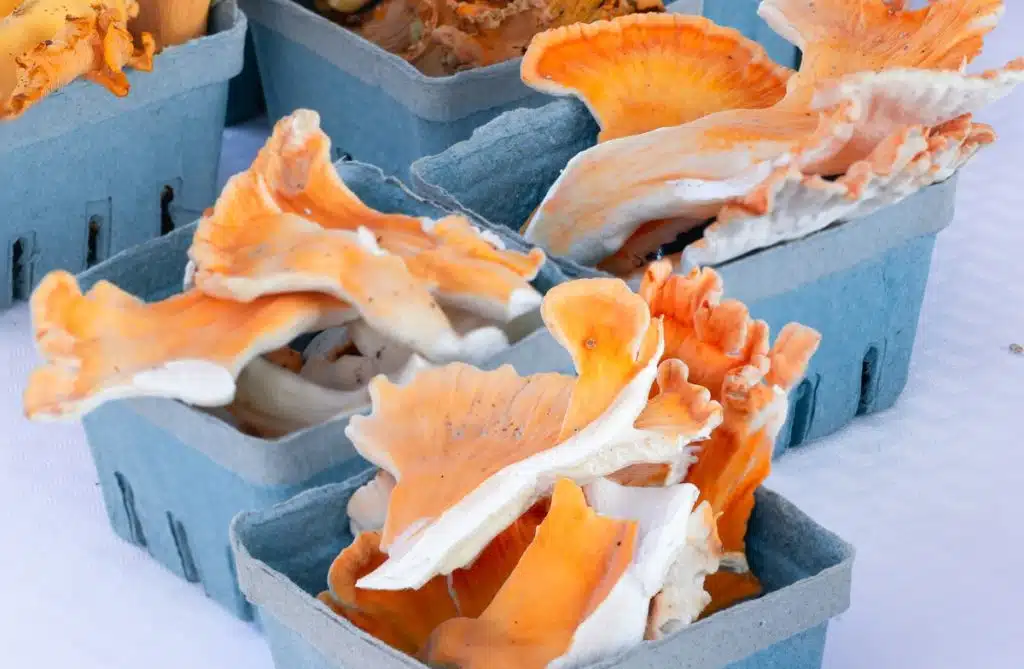
How to Identify Chicken of the Woods Mushrooms
Chicken of the woods are very striking and have few look-alikes making them an ideal species for beginner mushroom foragers.
They grow in overlapping layers, resemble small wavy shelves and vary in appearance from smooth to finely wrinkled.
Their broad fan-shaped caps can get very big and range from 2 to 12 inches (5 to 30 cm) across, with a velvet or suede-like feel when young that becomes leathery as they mature.
Chicken of the woods are polypores, meaning they do not have gills. Instead, the underside of their caps have lots of tiny tubes that look like pores, and these produce their spores.
Chicken of the woods mushrooms don’t have stems, the brackets emerge directly from the tree, but they sometimes have short pseudo or “false stems” that are actually part of the cap.
Their color varies from species to species, and as they mature, their bright colors fade and change, becoming tan or light brown.
The upper surface of Laetiporus sulphureus, often called the sulfur shelf mushroom, is orange-red to orange-yellow, usually with bright yellow wavy edges. The underside is bright sulfurous yellow with tiny pores.
Laetiporus cincinnatus, also known as the white-pored chicken of the woods, has a pale pinkish to peachy colored upper surface, and the underside is white with tiny pores.
The upper surface of Laetiporus gilbertsonii is pale pinkish orange or orangish-yellow, and the pore surface varies from lemon-yellow to pale lemon-yellow.
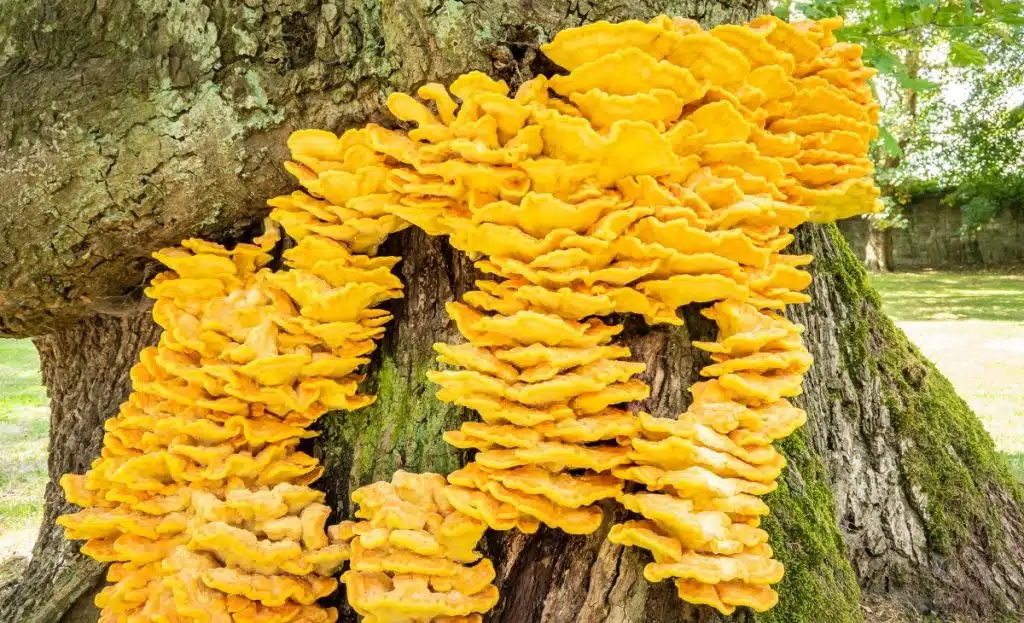
Chicken of the Woods vs. Hen of the Woods
Chicken of the woods and Hen of the woods are very different mushrooms. And although they’re not look-alikes, their similar names often cause confusion.
Hen of the woods or maitake is a delicious edible polypore mushroom that grows in clusters at the base of hardwood trees. And like some chicken of the woods prefers oaks.
But this is where the similarity ends.
Hen of the woods mushrooms have flattened brown caps with white edges and get their name from the fact that the dense cluster of mushrooms resembles the ruffled feathers of a sitting hen.
Chicken of the woods is brightly colored, looks nothing like a hen and gets its name because, when cooked, its taste and texture are similar to chicken meat.
Hen of the woods mushrooms taste nothing like chicken and have a rich earthy aroma and taste and unique texture.

How to Harvest Chicken of the Woods Mushrooms
It’s easiest to harvest chicken of the woods with a sharp knife, but some foragers pull the entire cluster off the tree.
Pulling often results in more wood particles and dirt that you’ll have to clean off the mushrooms later. It also damages the decomposing wood, which may result in fewer mushrooms the following year.
With a sharp knife you can harvest the entire cluster by cutting it off at the base or trim tender bits off the edges of mature caps.
Harvesting chicken of the woods mushrooms at the right stage is important if you want to eat them fresh.
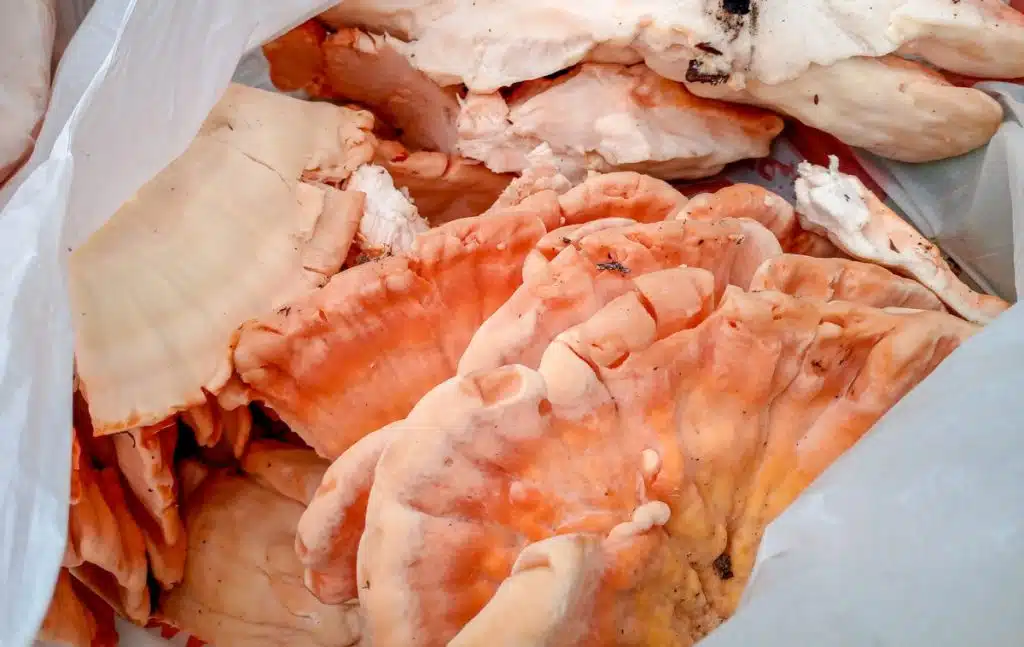
When is the Best Time to Harvest Chicken of the Woods?
The best time to harvest chicken of the woods mushrooms is when they are still young, with vibrant colors and a firm, slightly spongy texture.
They grow fast and can get past their prime in as little as 2 to 3 days, so if you find young chicken of the woods, it’s best to harvest them the same day or come back the following day.
Immature chicken of the woods mushrooms appear from dead trees as bumpy cyst-like knobs and a few days later start forming brackets.
They’re most tender before the brackets form. If you find them at this stage, it’s the perfect time to harvest them.
Prime edible chicken of the woods usually have brackets less than 8 inches (20cm) across with moist flesh, bright colors and a pleasant mushroomy smell. When crushed, they exude a watery, yellowish liquid.
As they mature and their brackets expand, the center part becomes tougher, but the outer edges remain tender. They also often become hosts to bugs and worms that enjoy their flesh.
At this stage, some foragers feel it’s best to cut off any soft sections on the edges and leave the rest for the bugs. But others harvest the entire cluster and use any tough sections to make a deciduous, savory chicken of the woods mushroom powder.
When a chicken of the woods reaches full maturity, the entire mushroom becomes tough and woody, and the colors fade.
At this stage it’s way past its prime and probably best left in the woods, although some people still use mature chicken of the woods for mushroom powder.
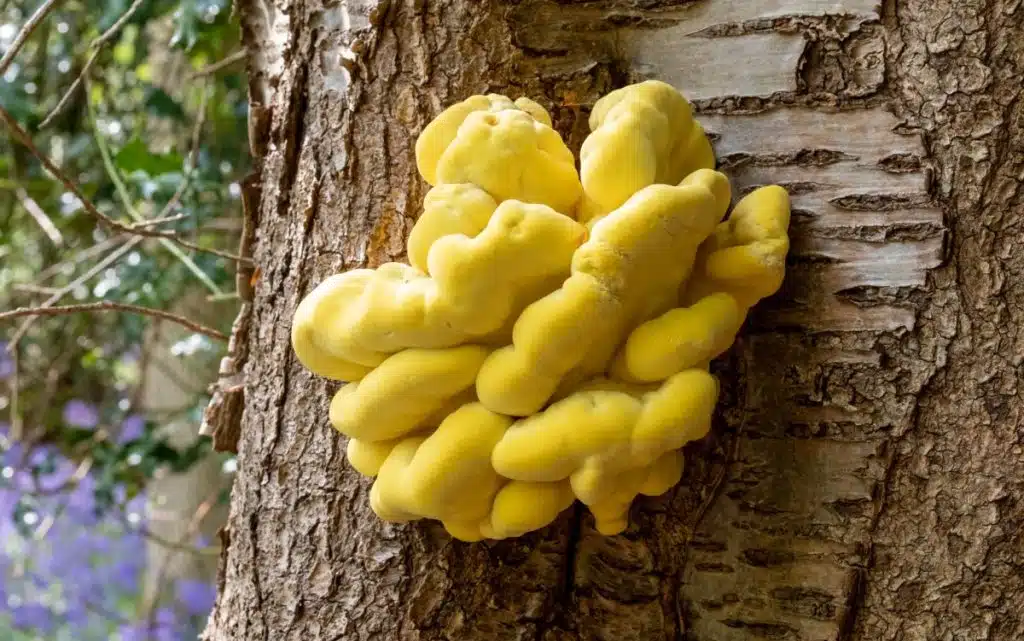
Chicken of the Woods Mushroom Look-Alikes
Chicken of the woods is one of the easiest mushroom species to identify, and there are no false chicken of the woods mushrooms.
Although some bright mushrooms may look similar from a distance, it’s easy to tell them apart when you get closer.
Bright yellow to orange mushrooms that grow in similar conditions are delicious edible chanterelles, parasitic honey mushrooms and toxic jack-o-lanterns.
But none of these mushrooms are bracket fungi, and they all have gills, so a quick look at the underside of their caps will quickly remove any confusion.
There is one polypore fungus, Phaeolus schweinitzii, that people sometimes confuse with chicken of the woods. It’s called the velvet-top fungus or dyer’s polypore.
It grows in similar conditions to chicken of the woods and, when young, is often bright yellow or orange, but the upper surface of the fan-shaped cap is velvety brown in the center.
The velvet-top fungus is not poisonous. But it’s also not edible as it has a very tough texture. People use these mushrooms to make natural green, yellow, gold, or brown fabric dyes, hence their second name.

Can You Grow Chicken of the Woods Mushrooms at Home?
You can grow chicken of the woods mushrooms at home, both indoors on sawdust blocks and outdoors on logs.
They’re one of the more challenging species to grow indoors, as colonization takes a very long time.
Because of this, indoor cultivation is usually only recommended for experienced growers who’ll enjoy the challenge.
But, if you have a shady spot in your garden, it’s easy to grow them outdoors on large-diameter logs and stumps. They prefer oak but will grow on most hardwood logs.
To inoculate the logs or stumps, you’ll need to drill holes in them, insert plug spawn or sawdust spawn and seal the holes with wax.
It takes six months to a year from when you inoculate your logs for the first flush of mushrooms. But then you should get mushrooms from your logs for another 3 to 5 years.
Our ultimate guide to growing mushrooms on logs takes you through this process step-by-step.
What Does Chicken of the Woods Mushroom Taste Like?
Chicken of the woods mushrooms have a mild flavor with lemony undertones that people describe as similar to chicken, lobster or crab.
But it’s their sinewy texture, so similar to succulent cooked chicken meat, that gives them their name and makes them a great meat replacement in vegetarian and vegan dishes.
Like other mushrooms, chicken of the woods absorbs liquids well and will take on the flavors of other ingredients in dishes.
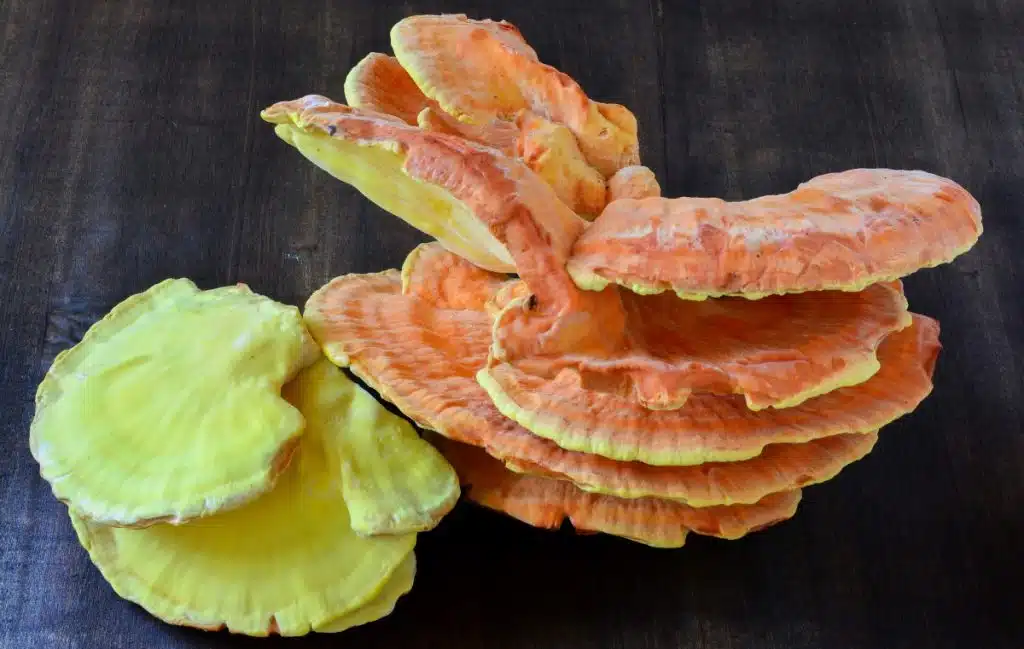
Can You Eat Chicken of the Woods Mushroom Raw?
You should not eat raw chicken of the woods mushrooms as they may cause stomach problems.
In fact, chefs advise cooking them thoroughly and, if necessary, boiling them before sauteing them to ensure they’re cooked through.
Some people are allergic to chicken of the woods mushrooms even when well cooked.
As with any mushroom you’re eating for the first time, it’s best to try a small portion first to see if you have any allergic reactions.
How to Clean Chicken of the Woods Mushrooms
If you’ve harvested an entire cluster of chicken of the woods, the first step is to separate the brackets and trim off any woody bits, bruises and insect damage.
Chicken of the woods growing at the base of tree trunks can sometimes get extremely dirty. Foragers recommend brushing them gently with a soft-bristle brush or wiping them with a damp cloth to remove any loose dust and debris.
You can also rinse them under cold running water to remove stubborn dirt. Then pat them dry with a clean paper or kitchen towel. Avoid soaking chicken of the woods as they’ll absorb a lot of water and become soggy.
Our article, “How to Clean Mushrooms: A Step-by-Step Guide,” has more information on the best ways to clean mushrooms.
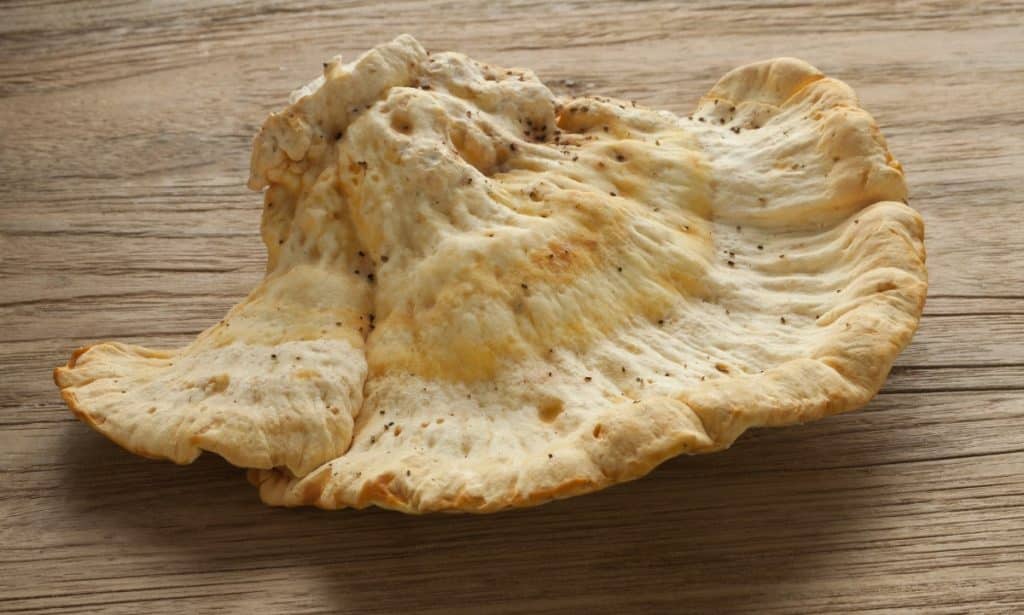
How to Store Chicken of the Woods Mushrooms
Here are three of the easiest ways to store your chicken of the woods mushrooms:
1. In the Refrigerator
You can store fresh chicken of the woods for 7 to 10 days in the refrigerator in a paper bag or breathable fabric bag, but there are a few things to remember to help them last longer:
- Store them on a shelf in your fridge, not in the crisper drawer.
- Take care not to place them next to strong-smelling foods.
- Avoid putting anything on top of them, as young mushrooms bruise easily.
Also, do not wash your chicken of the woods until just before you plan on using them.
2. In the Freezer
Because chicken of the woods often grows in large groups of several clusters, you’ll often end up with more than you can fit in your fridge or eat in a week.
In cases like this, you need long-term storage solutions, and freezing and drying are the best options for chicken of the woods.
Unlike most other mushrooms that need cooking before freezing, raw chicken of the woods freezes well and retains its meaty texture when defrosted.
To store chicken of the woods in the freezer, first trim and clean them and pat them dry or place them on a kitchen towel to dry.
Ensure they’re dry before freezing them because if you freeze them wet, they won’t retain their texture, and you’ll end up with soft mushy mushrooms.
Place the clean, dry chicken of the woods into ziplock bags or vacuum pack them and then freeze them. They’ll last for up to a year in the freezer.
3. Drying
If you plan on using your chicken of the woods in soups and stews, then drying them is also an excellent way to preserve them long term.
Trim, wash and dry your mushrooms, then slice them into half-inch (1.3 cm) pieces and dry them in a food dehydrator. Once dry, you can store them in an airtight jar or ziplock bag. They’ll last a year or more when kept in a cool and dry location.
You can also blend or grind your dried mushrooms to make chicken of the woods mushrooms powder for seasoning dishes. This is the best way to use older mushrooms that are too tough to eat but still have lots of flavor.
How to Cook Chicken of the Woods Mushrooms
Like other mushrooms, chicken of the woods is very versatile with many culinary applications.
You can fry, saute, blanch, roast or bake chicken of the woods and use them as you would other mushrooms or as a substitute for chicken or tofu in recipes.
What is Chicken of the Woods Mushroom Good For?
One of the easiest ways to enjoy the flavor and texture of these mushrooms is to sauté them in olive oil with garlic, shallots, white wine and fresh herbs.
But they also work well in pasta dishes, curries, casseroles, risottos and egg-based dishes like quiches, omelets and frittatas.
Below is a chicken of the woods mushroom recipe that really makes the most of their similarity to chicken meat.
And to provide more inspiration, we have put together 30 of our favorite mushroom recipes as well as 25 delicious vegan mushroom recipes.
Crispy Fried Chicken of the Woods Recipe

This recipe, adapted from the Forager Chef, uses the traditional chicken fried steak recipe to create tender, juicy mushroom steaks with a crispy outer coating.
You can serve these delicious steaks with any sauce and your choice of vegetables, creating endless possibilities.
Ingredients
- 4 pieces of young chicken of the woods, around 2 oz (57 grams) or the size of a smallish fist
- 1 cup all-purpose flour or as needed for breading.
- Salt and freshly ground black pepper to taste
- 1 pinch of sweet paprika
- 1 small pinch of cayenne pepper
- 3 eggs beaten
- 4 tablespoons of cooking oil
- 2 tablespoons unsalted butter
- A few sprigs of fresh thyme (optional)
- 1 small clove of garlic, crushed (optional)
- Lemon wedges for serving
Instructions
- Trim off the tough parts of your chicken of the woods mushrooms, rinse and dry them well, as this helps the seasonings adhere.
- In a bowl, combine the flour with salt, pepper, paprika and cayenne to taste, and place the beaten eggs in another bowl.
- Toss the mushrooms first in flour, then in egg, then in flour again.
- Heat a pan and add the cooking oil and butter. When the butter has melted, add your breaded chicken of the woods, the crushed clove of garlic, and the thyme.
- Sauté the chicken of the woods until they are golden brown on each side, about 4-5 minutes, adding extra oil or butter if the pan gets dry.
- When ready, remove the mushrooms from the pan, quickly blot them on a paper towel to remove excess oil, sprinkle with salt and serve immediately.
Health and Nutritional Benefits of Chicken of the Woods
Like many other mushrooms, chicken of the woods is high in protein and digestive fiber and low in fat, making it a healthy meat replacement.
It’s also a good source of potassium, vitamin C and vitamin A.
The nutritional value of chicken of the woods varies depending on the environment and growing conditions.
But studies on the nutritional value and chemical composition of chicken of the woods show that, on average, a 100g serving contains:
- 6 g of dietary fiber
- 21g of Protein
- 2g of fat
- 150mg of potassium
Chicken of the woods also contains numerous bioactive compounds with antioxidant, antibacterial, anti-inflammatory and anti-tumor properties.
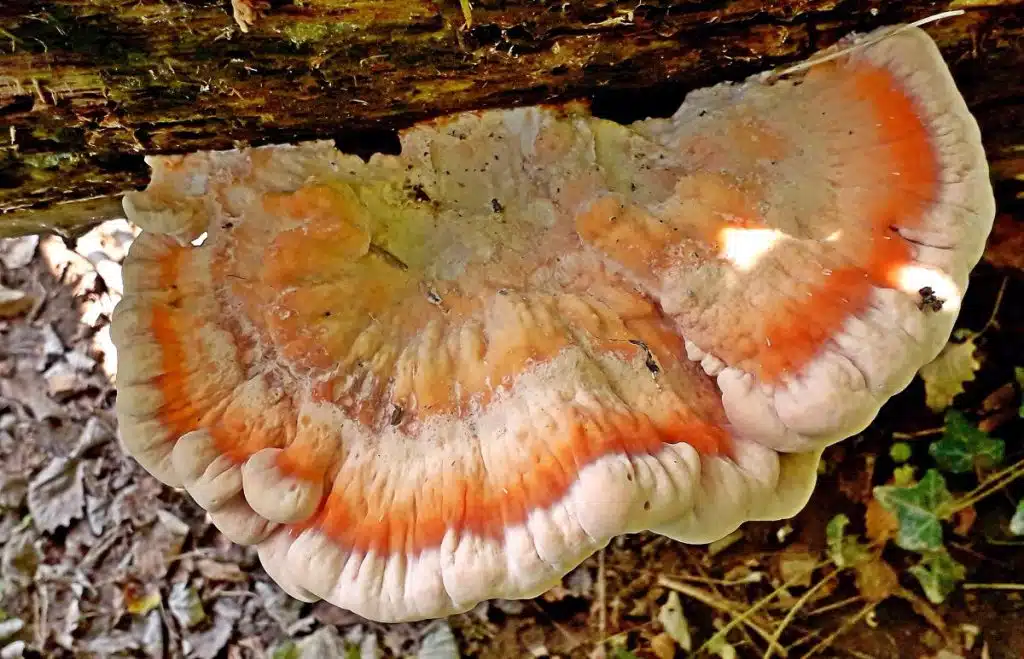
Final Thoughts
Chicken of the woods are delicious, edible mushrooms that are more often foraged than cultivated.
If you’re fortunate enough to live somewhere they grow, you could find fresh chicken of the woods in the wild, at your local farmers market or even grow them outdoors on logs.
Because they often grow in large clumps, you’ll have enough mushrooms to last a while and can store them in the freezer for a year-round supply of tender, meaty mushroom steaks.
To learn more about mushrooms and how they grow, visit our Mushroom Education Hub.
And if you’re hoping to grow mushrooms at home, our Mushroom Growing Hub has loads of valuable resources to help you get started.
